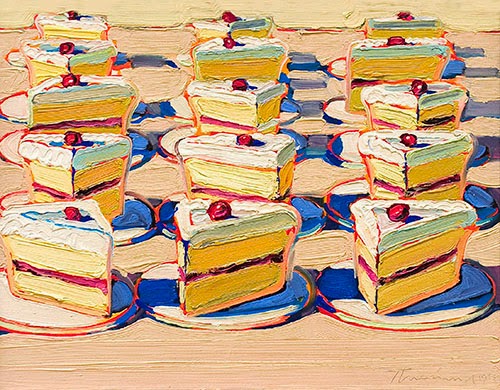We also talked about tints and how to make a color appear lighter using watercolors.
After talking about color theory, I showed them some of Wayne Thiebaud's paintings.
I had the students spend some time looking at his work and observing the variety of color. I went over shading and pointed out how he utilized some of the techniques we talked about in class.
For their assignment they were asked to paint their favorite dessert with watercolors. I asked them to use tints and shades to create dimension in the work. I wish I was a little more specific on the shading aspect of the lesson. I didn't do a demonstration with the different types of shadows and I think that would have been helpful for them. Also, Jayme recommended that I structure the lesson so that I demonstrate the concepts in segments and have the students practice it right after rather than showing them stuff all at once and then letting them free. I'm going to try that next time.
Here are the paintings. I was really impressed with some of their use of color!
Here's my lesson plan:
Wayne Thiebaud Lesson
Name
of Art Scholar: Rachel Jackson
Name
of Teacher: Jayme Gandara
|
Subject Concepts
|
Art Concepts
|
|
|
Content
Covered:
|
Content
Covered:
Color
theory and Shading
|
|
|
State Standards & Objectives (USOE/UEN):
|
State
Standards & Objectives (USOE/UEN):
Standard 1 objective 1
Standard 1 Objective 2
Standard 2 Objective 1
Standard 2 Objective 2
b. Portray a consistent light side closest to the light source
and dark side opposite the source of light in artwork.
|
|
|
|
Learning
Outcomes:
The student will be able to…
|
|
|
Lesson Plan
|
||
|
Objectives:
The students will learn about color theory and
shading. They apply what they’ve
learned by observing artworks by Wayne Theibaud and creating their own
dessert paintings that include tints and shades of at least one hue.
Assessment:
Students will turn in a watercolor painting that
demonstrates ability to mix a tint and shade to create a sense of dimension
of an object.
|
||
|
Materials
Needed:
Vocab:
|
Lesson
Sequence:
-Have
student’s point out the variety colors that they see. (especially arbitrary ones)
-Point out tints and shades
that can be seen in his paintings.
|
|
Visit: http://www.uen.org/core/ to find UEN/USOE
standards.















No comments:
Post a Comment